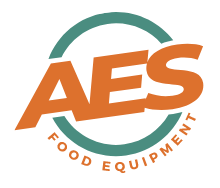In a sector where efficiency, hygiene, and regulatory compliance are non-negotiable, the right meat rail system is not just a convenience, it’s a cornerstone of operational success.
Whether you’re operating a high-volume abattoir, a specialist deer larder, or a retail butchery, your rail system must be engineered to suit your unique process. Anything less risks inefficiency, contamination, and avoidable downtime.
At AES Food Equipment, we’ve supplied and designed custom meat rail systems across the UK for over a decade and in our family for over 5 decades. Our experience confirms what many discover too late: generic rail systems fail to meet the realities of modern meat processing.
What Is a Meat Rail System – and Why It Matters
A meat rail system is an overhead framework that supports the movement of carcasses through a meat processing business. Some key processing zones include slaughter, dressing, chilling, cutting, and dispatch. It ensures safe handling, maintains hygienic clearance, and supports the pace of production.
Core components include:
- Track: Typically, aluminium twin track (modern standard) or galvanised round bar (legacy systems)
- Rollers and hooks: twin track meat hooks with nylon roller wheels or aluminium tubular hooks to galvanised skid hooks.
- Switches and junctions: Directing carcass movement around the area / chiller
- Mounting system: Bespoke support steel or cleats suited to your ceiling height and infrastructure – one of the most important parts of the rail system
Your rail system forms the backbone of your production layout. If it's wrong, everything else suffers.
Why a One-Size-Fits-All Approach Doesn’t Work
Every site is different. A rail layout that works in one facility may completely fail in another. The reasons are practical:
- Species variation – Cattle, pigs, lambs, deer: all demand different rail specs and hook styles
- Carcass volume and throughput – 10 deer a week vs. 50 cattle a day requires vastly different structural and flow considerations
- Ceiling heights and physical constraints – Old farm buildings, converted units, or purpose-built plants all need tailored designs
- Workflow preferences – Kill-to-chill routes, dispatch timings, multi-room flow all differ between businesses
- Future scalability – Planning for expansion now avoids costly refits later
Designing your system without factoring in these variables will result in either inefficiency or costly rework.
Key Considerations When Designing a Meat Rail System
1. Structural Load & Clearance
- Ensure the supporting steel sits above the rail and roller path, away from refrigeration equipment to ensure good airflow
- Allow at least 300mm clearance from the floor to the lowest part of the carcass
- Structural calculations must confirm safe load-bearing for peak carcass weight and volume
2. Material Selection: Aluminium vs. Galvanised
Aluminium Twin Track:
- Hygienic and lightweight
- Corrosion-resistant and easy to clean
- Now the standard for modern installations
Galvanised Round Bar:
- Lower upfront cost
- Common in legacy systems
- Requires more frequent cleaning and maintenance
Your choice depends on your budget, hygiene requirements, and whether you’re building new or upgrading an old system.
3. Roller, Hook & Switch Compatibility
- Choose meat hooks / rollers that match your rail
- Hooks must suit the species and method of dressing (e.g., gambrels for pigs or 18mm hooks for beef)
- Switches must support the roller type—mixing components can lead to breakdowns
4. Efficient Flow Planning
- Map the process for your facility
- Design for minimal manual handling and backtracking
- Use switches, junctions, and gravity flow where possible to improve efficiency
5. Maintenance and Hygiene
- Consider how the system will be cleaned
- Avoid dead zones or overlaps that trap organic matter
- Twin track offers a smoother, easier-to-clean surface than round bar rail
6. Room for Growth
- Include capped ends or pre-installed junctions if future expansion is likely
- Modular systems allow easier bolt-on rail sections or transitions later
Avoiding Common Mistakes
- Insufficient Headroom
- The most frequent and costly error
- Without adequate clearance above the rail line, supporting steel may block hook travel or cause carcasses to hang too low
- Mismatched Equipment
- Rollers and switches from different systems may not align
- Hook types that don’t fit the rail or curve radius will cause jamming or wear
- Poorly Planned Flow
- Cross-contamination risk increases if dirty and clean zones overlap
- Without a clear directional path, staff handling time increases and efficiency drops
- Overlooking Compliance
- Carcasses must remain above the floor at all times
- Structural designs must meet hygiene, inspection, and FSA criteria
- Undervaluing Expert Consultation
- Buying on price rather than fit-for-purpose design leads to retrofit costs and operational disruption
- Buying on price rather than fit-for-purpose design leads to retrofit costs and operational disruption
- Buying on price rather than fit-for-purpose design leads to retrofit costs and operational disruption
Our Process: Design-First, Not Product-First
AES Food Equipment delivers rail systems based on a proven consultative process:
- Operational Briefing – We assess throughput, species, workflow, and hygiene standards
- Site Visit – Our team measures, photographs, and maps available headroom and load-bearing points
- CAD Design & Quotation – Layouts include switches, brackets, and support steel with clear costing
- Installation or Supply – We provide either full installation or supply-only with layout support
- Aftercare & Upgrades – Ongoing access to replacement rollers, hooks, and additional components
Our systems include:
- Aluminium twin track with heavy-duty meat hooks / rollers
- Specialist hooks and gambrels for pigs, cattle, and sheep
- Switches and returns to manage multi-room flow
- Custom-fabricated steelwork for ceiling mounting or floor supports
- Roller refurbishment and compatibility upgrades for older rail system
Real-World Examples: Case Studies
Avalon Farm Butchery at The Newt in Somerset
At Avalon Farm, a premium estate committed to sustainable and regenerative farming, the goal was to create a high-quality, on-site butchery facility that reflected their brand values. Working alongside the estate team, AES designed and installed a full aluminium twin track rail system, complete with custom hooks and roller bodies. The layout was tailored to their product flow—from slaughter to cutting room—with consideration for hygiene zoning and animal welfare.
Key features:
- Purpose-built layout for seamless movement between slaughter, chill, and processing
- Custom stainless steel workstations and rail returns
- Organ rail included for internal product handling
- Clear floor clearance maintained throughout to meet audit requirements
This installation elevated both operational performance and customer-facing presentation, supporting Avalon’s high-end meat offering.
Gloucester Services Farmshop Butchery
Gloucester Services is renowned for showcasing local producers and artisan food. Their in-house butchery needed a robust and hygienic rail system to support growing demand. AES provided a modular aluminium twin track system, maximising the use of a restricted ceiling height without compromising compliance.
Highlights:
- Delivered a low-profile rail solution to work within tight structural limits
- Installed switches and rail curves to optimise workflow between chillers and prep areas
- Provided a long-term solution that allows for future system extension
This solution ensured that the butchery maintained its artisan ethos while improving throughput and efficiency.
Why Choose AES Food Equipment?
- UK-based with over 12 years of industry experience
- Full technical design and CAD layout capability
- Strong supply network with specialist European manufacturers
- Exclusive roller and hook systems built for abattoir environments
- Reliable consultation and aftersales support
We understand meat processing. From small game larders to high-volume abattoirs, our systems are built around your process—not the other way around.
Conclusion: Build a Rail System That Supports Your Business
Investing in a tailored meat rail system pays dividends in efficiency, hygiene, and operational resilience. Cutting corners leads to poor clearance, non-compliance, and unnecessary costs down the line.
Speak to our team today for a no-obligation consultation and let us help you design a system that works the way your business does.
AES Food Equipment – Built Around Your Business.
Overview
AES Food Equipment collaborated with The Newt in Somerset to create a cutting edge butchery facility at Avalon Farm. Designed to enhance meat production and supply capabilities, this standalone facility supports The Newt’s hotel, retail outlets, and online shop, with a focus on quality, provenance, and sustainability.
The Challenge
The Newt required a facility that could handle full-carcass butchery across various species while maintaining rigorous hygiene, efficiency, and traceability standards. AES Food Equipment was entrusted with delivering a custom stainless steel meat rail system, along with essential hygiene and butchery equipment, all tailored to meet The Newt’s unique requirements.
Our Approach
Collaborative Design & Planning
Working alongside The Newt and their architects, AES Food Equipment contributed critical insights into the design of the loading bays, meat chillers, and butchery preparation rooms. These details enabled the architects to prepare comprehensive tender documents for contractors. During the tendering process, we supported contractors by addressing technical questions to ensure smooth bidding.
Partnering with CG Fry & Son
After CG Fry & Son won the tender, AES collaborated closely with them and The Newt throughout construction. This partnership ensured the seamless integration of our twin track stainless steel meat rail system and other equipment into the facility’s design.
Tailored Solutions
AES supplied and installed key equipment to meet The Newt’s needs:
- Twin-track stainless steel rail system for efficient carcass handling.
- Hygiene equipment, including boot and apron washes, to ensure compliance with food safety standards.
- A carcass loading arm to simplify loading onto the rail system.
The meat chiller was equipped with a stunning glass viewing panel, allowing visitors to observe the butchery process in action.
The Result
The completed facility at Avalon Farm combines aesthetic design with practical functionality. Clad in glass and oak, the butchery reflects The Newt’s commitment to transparency and quality. It features a production area for full-carcass processing and a workshop space for training and education.
This facility now supplies beef, lamb, and venison from Avalon Farm, alongside locally sourced pork and poultry, to The Newt’s estate, shops, and online business. Visitors can experience the craft of butchery firsthand through workshops and training initiatives.
Client Testimonial
"Our new butchery has transformed the way we handle and showcase meat at The Newt. The collaborative efforts with AES Food Equipment have resulted in a facility that’s as functional as it is beautiful. It’s a space where craft and care come together, and it’s integral to our farm-to-table approach."– The Newt
Learn More
For more information about The Newt’s butchery and their commitment to high-welfare meat production, visit their official website.
Overview
Gloucester Services, renowned for its award winning farm shop and restaurant, approached AES Food Equipment to address a significant operational and safety challenge within their onsite butchery. Known for their farm to fork philosophy, Gloucester Services needed a solution that not only improved the efficiency of their butchery but also enhanced the visual appeal of their produce for customers.
The Challenge
The existing meat handling process at Gloucester Services required staff to manually carry carcasses from the loading bay through a corridor into the butchery, causing inefficiencies and potential health and safety risks. Meat was displayed using a flat bar rail system suspended from ceiling panels, one of which had failed, posing a serious hazard.
Due to the layout constraints of the shop, installing a traditional meat rail system from the loading bay was not feasible. AES was tasked with designing a solution that would:
- Eliminate the risk of ceiling panel failures.
- Improve the efficiency of stock rotation and meat handling.
- Create a visually engaging display of meats through the glass viewing window into the shop.
Our Approach
Bespoke Design for Space Constraints
After assessing the site, AES designed and installed a self-supporting meat rail system that operated independently of the ceiling panels. This steel-structured solution ensured:
- Enhanced safety – no weight was transferred to the ceiling, mitigating the risk of collapse.
- Efficient stock rotation – the new system allowed for smooth movement of carcasses, reducing manual handling.
- Visual appeal – cuts of meat could now be showcased effectively through the glass viewing panel, enhancing the customer experience.
On-Site Installation and Testing
AES worked around the operational hours of Gloucester Services to install the new rail system with minimal disruption. The self-supporting structure was designed to seamlessly integrate into the butchery, allowing staff to lift cuts of meat directly from the rail for preparation.
Maximising Customer Engagement
The revamped display turned the butchery into a visual centrepiece within the farm shop, aligning with Gloucester Services’ ethos of transparency and local produce promotion. Customers could now witness the quality and craftsmanship behind the counter, reinforcing trust and driving sales.
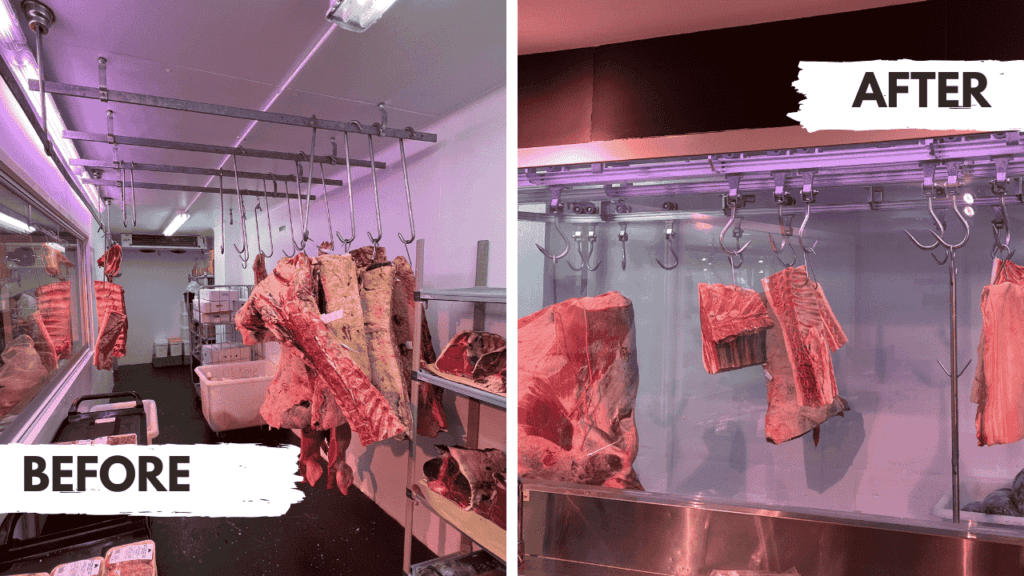
The Result
The installation of the self-supporting meat rail system has significantly enhanced both the safety and operational efficiency of Gloucester Services’ butchery. Not only has the risk of ceiling panel failure been eliminated, but the improved layout also provides a more immersive experience for customers. The butchery now serves as a showcase of locally sourced meats, reinforcing the farm-to-fork philosophy that Gloucester Services is celebrated for.
"The new self-supporting meat rail system has been a game-changer for us. It not only resolved the health and safety issues we faced but also enhanced how we display our meats to customers. The visibility through the viewing window has created a real talking point, allowing us to showcase the quality of our produce directly to those passing through our services."
Gloucester Services Butchery Manager
About Gloucester Services
Located on the M5 Southbound, Gloucester Services is one of the UK’s leading service stations, famous for its locally sourced produce, farm shop, and restaurant. A destination in itself, Gloucester Services offers travelers a unique experience that celebrates British farming and artisan food production.
Learn more about Gloucester Services here.
Over the last 50 years, various meat rail systems have been employed to hang and transport carcass meat within meat production facilities. In this blog, we will explore these types of meat rail systems, examining the benefits and drawbacks of each, and providing recommendations on the most suitable systems for your meat processing business.
Round Bar/Tubular Systems
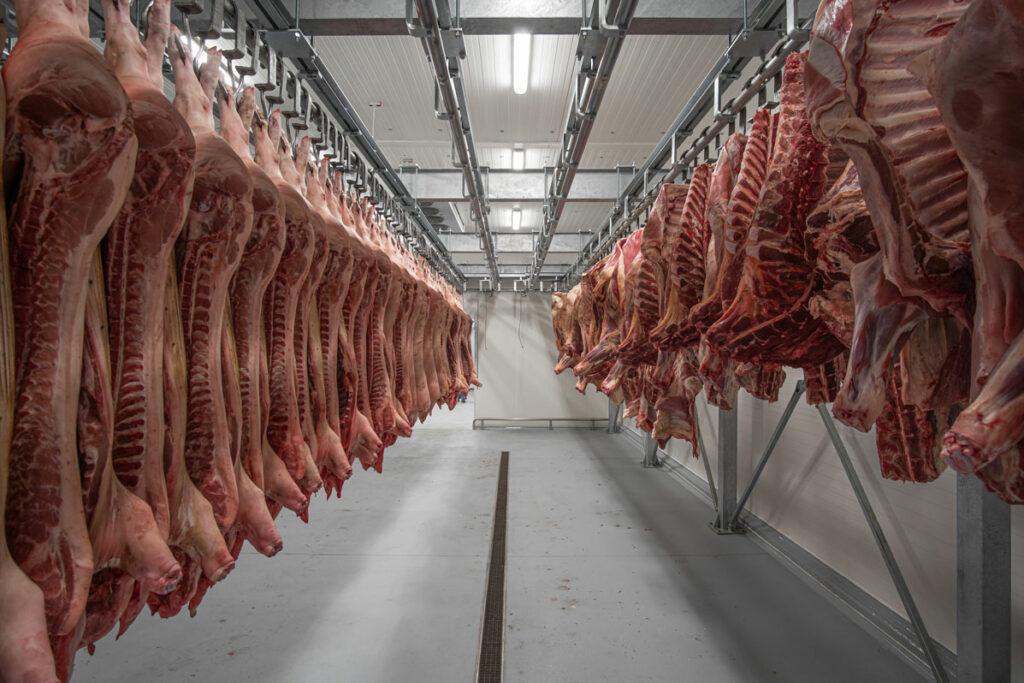
Round bar or tubular meat rail systems remain widely used in the UK across abattoirs, cutting plants, and butcheries. This system consists of a steel framework with galvanised metal hangers at varying heights, supporting steel tubes for meat skids and tubular roller hooks. Directional changes are managed via switches, available in 25, 45, and 90-degree turns, with newer rollover designs enhancing operator safety by preventing hooks from falling off the ends.
Commonly, the rail tubes are either 48mm or 60mm in diameter, with 60mm being prevalent in Europe. Notable manufacturers of round bar meat rail systems include Couedic Madore and Hocker. These systems can also feature pneumatic switches, allowing operators to change directions using a controller, where a ram turns over the switch.
Advantages:
- Cost-effective, using tubular galvanised tubes.
- Meat skids can double as hooks.
Disadvantages:
- Requires regular greasing for smooth hook movement.
- Potential safety issues with hooks detaching.
- Complex structural support may cause installation challenges.
Aluminium/Stainless Steel Twin Track Meat Rail Systems
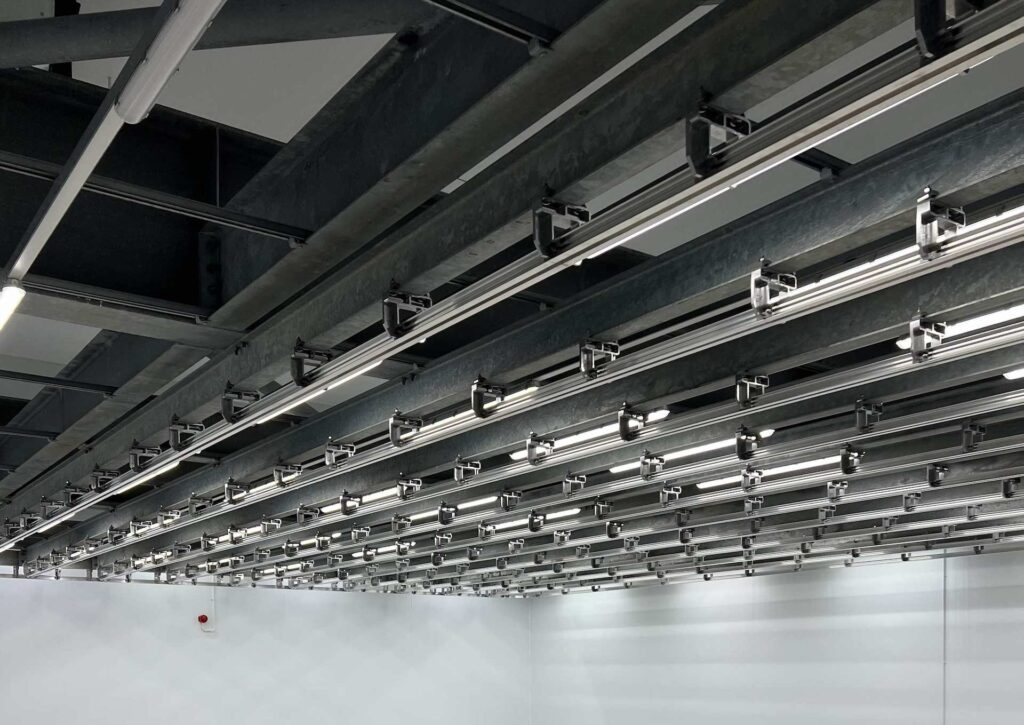
Aluminium and stainless steel twin track systems are the leading meat rail systems in the UK market, due to their numerous advantages. These systems feature a steel supporting framework with hangers that clip onto I-beams, holding two single extruded track profiles. The system utilises plastic-wheeled rollers for easy carcass movement.
Various switches, including 45 and 90-degree turns, as well as 3-way or 4-way directional switches, facilitate complex operational workflows. Notable manufacturers of twin track meat rail systems include Transuni, Biralux, Abachem and AES.
Advantages:
- High safety, preventing hook dislodgment.
- Easy carcass movement due to plastic rollers with bearings.
- No need for greasing, reducing maintenance and cleaning efforts.
- Corrosion-resistant materials like aluminium and stainless steel.
- Easy to upgrade or modify without specialist machinery.
Disadvantages:
- Space requirements for installation, particularly in smaller chillers or cold rooms.
- Necessitates a supporting structure.
Flat Bar Systems
Once common in the UK, flat bar systems are now primarily used in North American meat processing facilities. These systems, supported by a steel framework, involve a flat bar where hooks with single wheels sit on top.
Advantages:
- Cost-effective.
Disadvantages:
- Lack of available flat bar switches.
- Safety concerns with hook attachment.
- Susceptibility to rust.
Self-Supporting Aluminium Rails
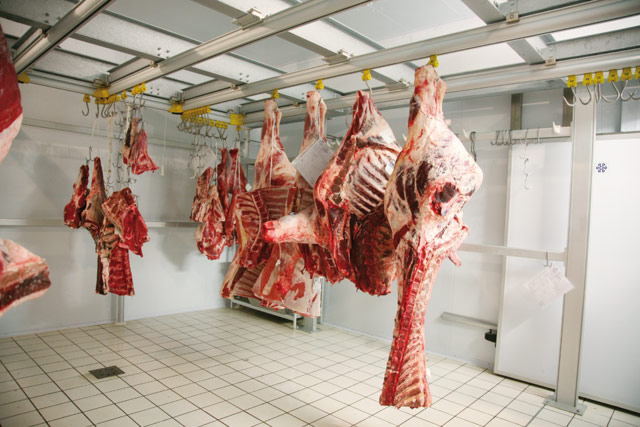
This modern European meat rail system integrates a self-supporting aluminium structure, simplifying design and installation. The system features plastic switches and pulls for directional changes, with hooks seated on small wheels inside the rail. Notable manufacturers of self supporting rail systems include Italmodular and Tonon.
Advantages:
- Streamlined design and installation process.
Disadvantages:
- Lower SWL (Safe Working Load) for hooks.
- Requires numerous supporting columns, impacting floor space.
- Potential operational delays due to sticking plastic components.
Choosing the Right Meat Rail System
Selecting the appropriate types of meat rail system depends on several factors: existing infrastructure, available supporting steelwork, facility size, and operational requirements. Generally, the aluminium twin track rail system is recommended for most meat processing facilities. At AES Food Equipment, we distribute leading suppliers of this rail type and can match your existing layouts.
For more information or to discuss your specific requirements, please contact us.
